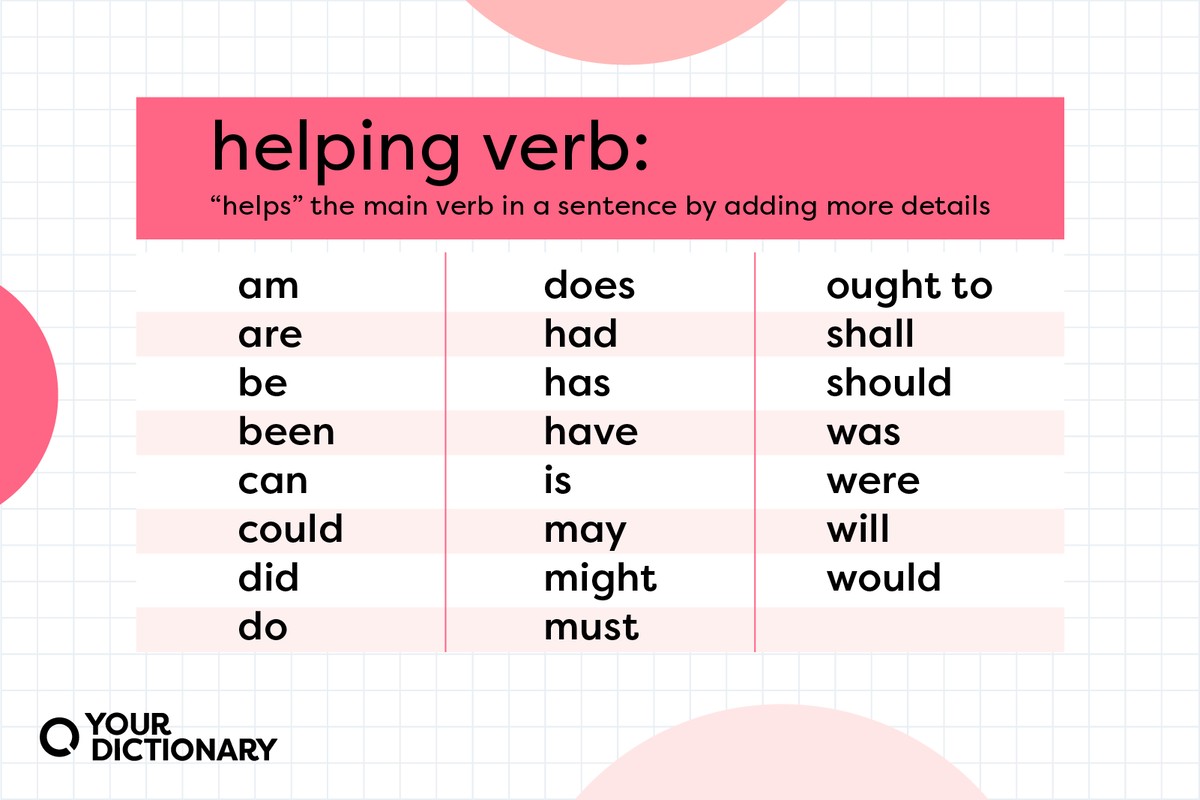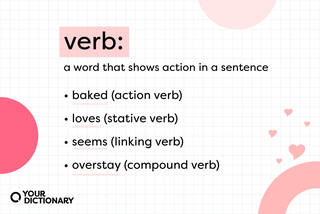
Helping verbs “help” the main verb in a sentence by adding detail to the main verb. There are two types of helping verbs. One type creates verb tenses by clarifying when an action happens, and the other type of helping verb establishes the mood of a sentence.
So when should you use each type — and when should you use a linking verb instead?
Helping Verb Type 1: Auxiliary Verbs
Auxiliary verbs help express verb tense in a sentence. The three most common auxiliary verbs are to be, to have, and to do — and all of their verb forms.
- to be - am, is, are, was, were, be, been, being
- to have - have, has, had, having
- to do - do, does, did
Auxiliary verbs always appear with an action verb in a sentence to create a verb phrase.
Examples of Auxiliary Verbs in Sentences
When auxiliary verbs appear in a sentence, they’re paired with the past or present participle form of an action verb to create different verb tenses, particularly the perfect tenses and the progressive tenses.
You can use forms of be to show progressive tenses:
- I am having another piece of pizza.
- Marissa is making dinner for us now.
- They are planning to go out of town.
- I am renting my guesthouse to my neighbor.
- Steve is starting a new personal training business.
- Christopher and Bernadette are moving to Baton Rouge.
- It is raining almost every day.
- We were planning our next vacation.
Forms of have appear in perfect tenses:
- I have grown tomatoes before.
- Who has traveled to Colorado?
- He had asked if he could take that blanket.
- She had stolen the car by then.
- Beth has worked here for a long time.
And you use both be and have in perfect progressive tenses:
- He has been running for over an hour.
- I had been dreaming about you when you called.
- Dave has been working on the task all day.
- The plants will have been growing a month by the time the stakes arrive.
The auxiliary verb do doesn’t set verb tense. Instead, it shows emphasis on the main verb in the sentence, makes the main verb negative, or changes the sentence into a question.
- I do find that show amusing. (Emphasis)
- I do not find that show amusing. (Negative)
- Do you find that show amusing? (Question)
Helping Verb Type 2: Modal Verbs
Helping verbs that show possibility, ability, suggestion, necessity, or permission are called modal verbs.
Unlike auxiliary verbs, modal verbs aren’t conjugated, so there is only one form of each verb. They come before the base (unconjugated) form of a verb.
The nine main modal verbs in English are:
- can
- could
- may
- might
- will
- would
- shall
- should
- must
In addition, the phrases ought to, need to, and had better often function with the main verb of a sentence to form a verb phrase.
Modal Verb Example Sentences
When a modal verb appears in front of another verb, it changes the modality of that verb.
- Sal can name all the U.S. presidents.
- I wish I could sing.
- My family may leave a day early.
- I might eat pizza for dinner.
- The students will read two books this weekend.
- Would you mind if I stayed here for a while?
- Who shall volunteer to lead the committee?
- You should go home and lie down.
- When it's your turn, you must go.
- This ought to fix the problem.
Is “Not” a Helping Verb?
You may see the word not (or its contraction form) alongside the main verb in a sentence.
But not isn’t a helping verb, nor is it a verb at all — it’s an adverb that often accompanies a helping verb to make the sentence negative.
- I will not accept any late homework.
- (Helping verb will and adverb not modify the main verb accept)
- Ted is not getting the promotion this year.
- (Helping verb is and adverb not modify the main verb getting)
- You can’t be serious.
- (Contraction can’t combines helping verb can and adverb not to modify the main verb be)
Helping Verb vs. Linking Verb
Are helping verbs and linking verbs the same thing? Not quite.
While helping verbs “help” other verbs to change the time or meaning of an action, linking verbs can stand alone as the main verb. They connect the subject of a sentence to more details about it (known as the subject complement).
- Helping verb - I have seen you around school.
- (Seen is the main verb, not have)
- Linking verb - You look wonderful today.
- (Look is the main verb)
- Helping verb - Oliva was finishing her homework.
- (Finishing is the main verb, not was)
- Linking verb - Olivia became a star student.
- (Became is the main verb)
It gets a little tricky when you consider the verb be, which can function as both a linking verb and a helping verb.
Just check to see if be is the main verb in the sentence — if it is, then it’s a linking verb, not a helping verb.
- Helping verb - I am doing the laundry.
- (Doing is the main verb, not am)
- Linking verb - I am tired of doing the laundry.
- (Am is the main verb)

What Is a Verb? Explanation, Usage, and Examples
Helping Verb vs. Action Verb
Another type of verb, action verbs, show that an action takes place in a sentence. They often use helping verbs to establish tense or modality.
- We are winning the game.
- (Helping verb is are; action verb is winning)
- Peter does like to play poker.
- (Helping verb is does; action verb is like)
Both have and do can also function as action verbs. Have as an action verb means “to possess something,” and do as an action verb means “to perform a task.”
Watch their context in a sentence to see if they’re functioning as helping verbs (before a main verb) or action verbs (the main verb).
- Helping verb - Trey has worked here for ten years.
- Action verb - Trey has many friends at this company.
- Helping verb - We do want to help our community.
- Action verb - We do many community projects.
Quick Tip
Look at the word that comes after have or do.
If it’s a verb, have and do are functioning as helping verbs. If it’s a noun, have and do are functioning as action verbs.